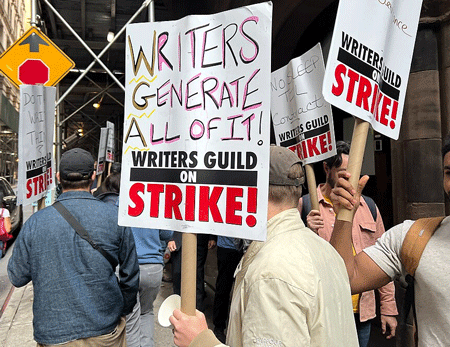What looks like “same old, same old” is anything but
Although two industry strikes and a carriage dispute may look like business as usual, 2023’s entertainment fights are different and signal significant changes to the industry.
By Jeffrey Cole
It used to be so predictable.
Every few years, one of two disputes (strikes or cable carriage wars) would routinely break out in the entertainment industry. After many threats and a lot of histrionics, issues would be settled (sometimes quickly, sometimes not), and then it would be back to business as usual.

Credit: Fabebk
But in the summer and fall of 2023 when both clashes broke out at the same time, it was very different. This time the disputes are existential.
It is not business as usual.
Now that both disputes have been settled (subject to a guild vote on the strike agreement), the business will never be the same. The year 2023 is a dividing line.
Dispute #1: The Writers Guild and Screen Actors Guild go on strike
The Writers Guild Strike began on May 2. Later in the summer, the Screen Actors Guild joined the strike—the first time two guilds have both been on strike in over 60 years.
Entertainment industry strikes are like cicadas, they appear around every fifteen years or so. The issue is always a new technology that emerged since the last agreement. That meant the writers, directors, and actors had no financial participation in the new technology—television in the 1960s, cable in the 1980s, the internet in the 2000s, and, with this strike, streaming. A new agreement has to be reached.
Historically, these strikes have always been reactive, trying to fill a gap that technological advances have created.
A key difference in the 2023 strikes is the fear of artificial intelligence. For the first time, the guilds are trying to be proactive with AI, although reactive to streaming. The problem is that no one really understands how AI will affect the business, so it will be difficult to tackle the issue. The real work of dealing with AI will come in later agreements when we begin to understand its impact.
Another strike over AI in the future is likely.
Strikes either end quickly or go on for a long time. This was one of the longest and it was mean and ugly. Someone in management was quoted as predicting the strike would end when the writers lose their homes. The unions are infuriated by management (many of whom earn millions of dollars a year) calling their demands unreasonable.
The economic gap between executives and talent has never been so wide.
Dispute #2: Charter v Disney
The other predictable dispute this year was between Charter Communication (owner of Spectrum Cable) and Disney over the cost of carrying programming including ABC, FX, National Geographic, ESPN, the Disney Channel, and more.
When broadcast television came over an antenna (the first forty years), it earned its revenue through advertising. When cable came along in the 1980s, the channels successfully argued that cable companies had to pay for the right to carry their channels, even the ones available for free through the air. Thus, cable channels have two sources of revenue, advertising, and cable fees.
Over the years, fees have become critically important to the producers of the channels, especially Disney.
ESPN became the greatest money-making machine in entertainment history. Because it was buried in a bundle, ESPN, at its peak reached one hundred million cable customers paying over $8 a month without knowing it. Even if customers had zero interest in sports, they could not opt out of buying ESPN. On top of over $800 million a month in fees, Disney also sold advertising on ESPN.
All the studios created new, spinoff channels and forced the cable companies to pay new fees because they were also part of a required bundle. At Disney this meant, FXX, FXM, Disney Junior, Freeform, Nat Geo Wild, and other channels that subscribers didn’t really want, and which added to the cable bill.
Cable television used to be a lucrative business. Even with hardware, maintenance, and labor costs, companies could make immense revenue simply by carrying someone else’s content. As costs of content rose, cable companies looked to providing broadband, which didn’t have fees for content, as a better source of revenue. Then they added internet phone and even cellular service. These services came along to compensate for the decline of cable television because, as fees rose, millions of homes (now 20,000 a day) cut the cord.
The studios rely heavily on the fees they get from cable. Disney has lost over a billion dollars in theatrical film over the last year and almost as much on streaming. It has used its cable fees (over $2 billion a year from Charter, the number two cable company) to fund its staggering costs in streaming and film.
When Charter refused to pay Disney’s price increases, it was more than a typical cable carriage stalemate. The cable companies saw it as an existential war. Chris Winfrey, the CEO of Charter said he was prepared to exit the television business and rely on broadband and other services. If he did—and if Comcast (the largest cable company) and others followed—then Disney would lose billions.
It is not business as usual. Now that both disputes have been settled (subject to a guild vote on the strike agreement), the business will never be the same. The year 2023 is a dividing line.
It was an existential war for Disney as well. Throughout the previous disputes, the content providers had all the leverage: cable customers wanted the channels. But as that content became ever more expensive, customers moved to alternative technologies such as YouTube TV or Hulu TV.
If Charter prevailed, it would change the power dynamic of the entire media content business, which is exactly what the company wanted. Disney would lose billions of dollars essential to covering their loses and to building new businesses.
It was not just another dispute.
The two parties settled after 11 days with both sides letting it look like a draw.
But in truth, Disney lost. The leverage shifted to the cable companies for the first time. No one knows if Charter’s Winfrey was bluffing when he threated to exit the television business. He did get some tangible benefits from the threat. Disney took a number of channels out of the required bundle, cutting Charter customers’ bills. While those channels are still on other cable systems, they will disappear as soon as those companies reach agreements with Disney. Disney Junior, FXX, Freeform and five other channels are, for all intent and purposes, dead.
Charter also won the significant right to offer the basic, ad-supported level of Disney+ and ESPN+ streaming services, to its cable customers at no added cost.
The playing field has been re-arranged.
These two events, industry strikes and cable carriage wars, occur regularly. They frequently are heated with threatening rhetoric but usually settle quickly. In the case of carriage disputes, the settlement is almost always in favor of the content creators.
This time they were not typical disputes. They were ugly with many wounded relationships that will not soon be healed.
What is different this time are the profound changes in the entertainment industry. Cable is dealing with customers who do not want to pay for content that they do not want. The music industry learned this painful lesson a generation ago.
The strike is dealing with dangerous income inequalities between the guilds (even the highly paid members) and management. At the moment, broadcast television, cable, most theatrical films, and much of streaming are all losing money. This year, even Disney’s theme park attendance was down.
The industry is desperately looking for new economic models. The costs of content have escalated beyond any reasonable expectation of making profits. Look at the release of five $200 million films within a month of June, all massive financial bombs. The industry is also in desperate need of a leader across the companies who can get the players on the same page to address these existential issues.
The new leaders may come from Apple, Alphabet (Google), and Amazon who can easily manage costs that are crippling to Disney, Warner, Paramount, Sony and Universal.
What used to be easily managed has become unmanageable.
This will be the story of the entertainment business for the next few years.
____________

Jeffrey Cole is the founder and director of The Center for the Digital Future at USC Annenberg.
See all columns from the center.
September 27, 2023

